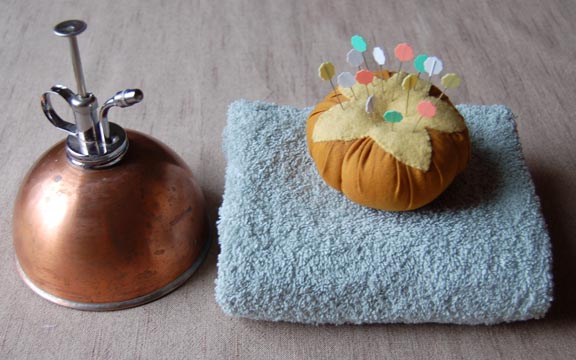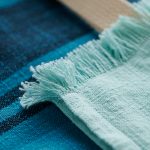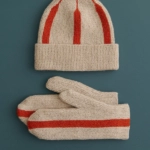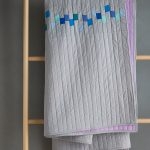Blocking
Blocking is a handy technique for stretching, easing, and redistributing stitches in a finished piece of hand knitting. Whether you are preparing to sew pieces of a sweater together or simply finishing a scarf like the one shown here, blocking creates a beautifully even fabric, which makes it easy to work with and lovely to wear.
You can block any type of natural fiber for any type of garment, as long as you are gentle. The goal is to get the knitting into a desired shape without stretching it out or damaging the fibers. These directions work best (in our experience) for all types of natural fibers from mohair to cashmere, cotton, silk, and blends.
Materials for Blocking

Here’s what you’ll need:
blocking pins – We recommend Clover’s flower head pins because they are sturdy, rust-proof, and cute
spray bottle – Any spray bottle will do as long as it is clean. We love this old copper gardener’s sprayer.
towel – Choose a towel that is big enough to fit your knitted pieces, and not too linty.
soft surface – You can use your ironing board for small projects, or your bedspread, the carpet, or a fabric covered couch cushion for larger projects. You’ll be sticking pins into the towel on top of this surface, so choose something that won’t mind getting a few stray pin pricks.
To make a portable blocking board, cover a 18 x 24-inch piece of 1/2-inch plywood or MDF with cotton batting. Staple it to the back using an upholstery stapler. Cover the batting with cotton fabric, attached with velcro so you can remove it for washing after a while.
Step 1: Hand Blocking

Stretch the knitting horizontally, vertically, and diagonally, several times in each direction. You will be able to see progress after a few rounds; the stitches should appear more evenly spaced. Different fibers call for different amounts of elbow grease, so don’t yank on lacey cashmere as you would ropey linen! The key is to simply watch the knitting and adjust your strength accordingly.

Step 2: Pin + Spray
Lay your knitting out on the towel. If it is a shaped piece, a sweater back, for example, you may want to stretch it slightly into the shape you desire. If it is a scarf or other simple rectangle, lay it down so that it is flat, but not stretching unnaturally.
Begin to pin around the edges of your knitting, being careful to maintain the shape you want. Once you have pinned around all sides, spray the piece with water and leave it to dry. Be patient! It may take a few hours, or even overnight.

Heavy Duty Blocking
If you have a hat that’s a hair too small, or a sweater a few rows too short, you may want to try a more aggressive blocking technique:
Rather than pinning and spraying the piece, submerge it in a bath of room temperature water.
Remove to a clean towel and roll it to get out excess water. Don’t wring or twist the knitting while it is weak and wet! Be gentle!
Hand block the damp knitting to the desired size and pin it into place. Let it dry thoroughly.





Hello, my cousin is making a bedspread, not in blocks, and is having trouble with keeping the stiches the same when she starts the next day. The stitches are looser than the day before. She is using a size 10 hook and the yarn is the thickness like jute string. Is there any way that she might be able to correct this? Even a sugestion on how to “block” a large bedspread would help.
You can email me back answers and I will also watch here.
Thank you very much.
Hi Punky,
This often happens with large projects. It should mostly resolve itself when she blocks it unless the difference is wildly different. You can block just as it says here, but lay the blanket on a large sheet or similar. You can skip the pins or sometimes its possible to pin into a rug (just be sure your colors won’t run once the project is wet!).
Hope this helps!
Is there more to blocking than understanding that it is a good idea? Not sure how to access the rest of the article if there is more.
HI Fonda-
Sorry for the confusion, this is an older post so the links are a little funky. The whole tutorial can be found here: http://purlbee.squarespace.com/blocking-tutorial/
Thanks for writing in!
Molly
The older link to blocking won’t work. Any other way to get the whole blocking tutorial?
Hello Joan,
Thank you for reaching out! Are you referring to the product link to the “Clover’s flower head pins” in our blocking tutorial? It should be all set now.
I hope this helps and happy knitting!
-Marilla
Hey, I'm making your bandana Cowl and I was wondering in what shape I should block it? And how do I get both sides if it's pinned down?
Thank-you!
If my "easy peasy" knit hat is a little too big will blocking help it?
Hi Vicki D,
It might! It depends on the yarn and fiber, but it would certainly be worth a try!
Thanks for asking and good luck!
Whitney
I've appreciated your finishing techniques. Some time ago I had knitted a turtlenect sweater. Now, my dilemma is what is the best way to seam the sleeves, upper and lower seams, as both edges are bind-off or cast-on rows. Sweater was worked all in garter stitch. Those being horizontal I'm not sure how to finish. I have recently started knitting again so pretty much a beginner. Thanks.
If the yarn I am using is 75% nylon & 25% wool– should that be blocked? I have made scarves that grow very long as they are worn and I am trying to stop that from happening again. Thank you.
Hi Nan-
You can block any type of fiber but blocking won't stop a scarf (or any garment) from stretching. Blocking is just used to make the fabric and stitches more even and smooth. It's kind of like ironing!
Thanks for your question!
Molly
I've been teaching myself Tunisian crochet, some of my work curls in on itself. Will blocking help?
Hi David,
From my experience and from what I've read online, Tunisian crochet does have a tendency to curl, but if you have worked at a loose enough tension, your piece will easily block out nice and flat.
Thanks for asking. Let us know how it goes and good luck!
Whitney
Excellent instructions! Thank you for this simple tutorial.
Thanks for the tips. I love the pattern of the scarf you used to demonstrate blocking. Would you be so kind as to share it? 🙂
Hi Nina-
This pattern is no longer available on our site but you can access it by clicking at the bottom link on its Ravelry page here: http://www.ravelry.com/patterns/library/basketweave-scarf-5
Thank you!
Molly
How do y keep your Tunisian square from curling any thing to help me would be appreciated mine wants to roll up rsap
Its a Tunisian squares I don’t know what causing it
Hi Matthew,
It’s true that Tunisian Crochet has a real tendency to curl. One way to reduce this tendency is to use a hook size several sizes larger than what you would use to normally crochet with the yarn you’re using.
Once you’re finished, blocking your piece really does help. Just soak it in warm, soapy water; rinse it; roll it in a towel and squeeze; then lay it flat to dry. If you crocheted with a loose enough tension, your piece should dry nice and flat!
Thanks for your question and please let us know if you have any others!
Whitney
Thanks! If I’m making a blanket out of granny squares sewn together, is it best to block the squares and then assemble? Or assemble then block?
Hi Kim!
That is entirely up to you! If you feel as though your squares are not quite square, or if they don’t fit the size they should, feel free to block them separately first.
Happy Crocheting!
Thomas
This is my first time crocheting Tunisian. As you said I have that small curl at both ends, so I wanted to try blocking (I’ve never done that before either!) Does it matter which side is facing/pinned up?
Thank you,
Stacy
Hi Stacy!
If you are fully submerging, then it shouldn’t matter which side is up when you block!
Happy Crocheting!
Thomas
I’m wondering how long an item stays in its blocked shape. Do you have to repeat this process? How often? Or is it something you just have to do once? What about after washing the garment? Thanks!.
Hi Katrien-
It just depends on what the piece is, you can certainly always re-block something if it is looking a bit out of shape, but it’s not something you need to do every week or anything. I like to lie my hand knit items flat to dry after hand-washing which is a light form of blocking!
Thanks for getting in touch!
Molly
This is my first time to do a wet block on my first project, a cardigan. Everything measures to size after knitting. My sweater is on a blocking mat as I write, my sweater seems to be 3 inches longer. It doesn’t appear stretched, but somehow the width is good, but the length is longer. I didn’t wring the sweater. I was being super careful not to wring, but I did squeeze it gently to get most of the water out and then roll it on a beach towel and stepped on it. Will it the length get shorter as it dries? My sweater looks great on the blocking mat, stitches are to place, but I don’t know what happened to the length.
Hi! Thanks for writing! There are certain fibers that can relax quite a bit when you get them wet. Bamboo, for example, can tend to loosen up considerably, and silk. What fiber is the sweater you just blocked? Chances are it should be fine and it’s not uncommon for work to spread out a bit when it’s wet, and to then dry correctly. If you do find that you’re working with a fiber that might grow when you get it wet, a useful step is to knit up a swatch of the yarn prior to making your garment, just to see how it handles when wet. If you find that you have a great deal of stretch and growth after you block your swatch, you can take your gauge measurements after blocking as more accurate indication of what might happen to your finished garment. Hope this helps and let us know how your piece turned out!
Thank you Purl Soho! Another wonderfully clear tutorial!
LOVE your work! Only wish you were in Australia!
Thanks again.
Kate
Could you please advise whether I block a hat before or after attaching an i cord .
Many thanks
Pat
Hello Pat!
What are you making? Unless you think the size of the item’s body will be drastically changed by blocking, I would finish the entire border, weave in the ends and then block it all together.
Best of luck! -Alyson
just finished knitting an afghan the borders were knit 7stitches and then do the pattern. the border is rolling up and I don’t know what to do. it also say to block the afghan ,how do I do a large piece like this
Hello Elaine!
Is your afghan made with a lace stitch pattern? If it does, I would recommend spraying the blanket until its slightly damp so and then pin it down so that it dries flat. The knit garter stitch border should be a great foundation in order to keep the blanket from curving in after blocking.
Let me know how it turns out! Best of luck! -Alyson
I steamed the ribbing in a diaper cover because it was curling. Now it seems to be stretched out. Can I fix it?
Hello Karen!
What is the diaper cover made of? Depending on the fiber content, you may be able to dampen the item again and sort of scrunch it into place. This will most likely be possible with 100% animal fibers. Best of luck! -Alyson
Hello,
I’ve just completed the Jasmine scarf using Flax Down. Which blocking method do you recommend?
Hi Stephanie-
We recommend the light blocking method laid out in the tutorial here! Thanks for getting in touch!
Molly
Hello! I used your pattern “color tipped scarf” with similar fibered yarn and the scarf keeps curling no matter how many times I have blocked it. Do you have any tips?
Hello Caroloine!
Did you get a chance to check your gauge while working up this pattern? Since the Color Tipped Scarf is knit in garter stitch, it should have very minimal curling. The only thing I can think of that could have caused the curling is if your gauge was significantly tighter than the sample’s recommended gauge.
If the yarn you used is mostly animal fiber, then you should be able to steam it gently and it will lay more flat than if you had simply got it damp and then laid it out to dry. Give that a try and let us know how it turns out! -Alyson
Hello Purl Soho, I made a large wrap with your beautiful Linen Quill and want to know the best way to block it. I need it to be ready for this Saturday and was hoping I could use your method outlined above. I am afraid that if I immerse the wrap completely, wrap and dry and then block, it may not dry in time. What do you suggest?
Thank you for your time.
Hi Gail,
Thanks for writing in and congratulations on finishing the wrap! You can use the method described above but given you time constraints, I would suggest steam blocking. To do so, you will need a steamer OR an iron with a steam function. You will place your wrap, laid out on a towel and turn on your steamer or iron and get the steam going. Hold the iron over the wrap but do not put it on the wrap and puff steam. You will then use your hands to press the wrap out. You can pin out the edges to keep them flat if you like. The item should dry fairly quickly using this method and be ready for Saturday.
I hope that this helps!
Cassy
I knitted a cowl and it needs blocked. How would you block it? Thank you
Patricia
Hi, Patricia!
Thank you for your question! I recommend blocking it as outlined above in Steps 1 and 2. Please let us know if you have further questions!
Best,
Kumeko
I am finishing up the Tunisian Crochet Scarf and I used the Alpaca Pure yarn that the pattern called for. How do I block it? Thanks for your help!!
Hello, Stephanie!
Thank you for your question! Since Tunisian Crochet makes such a dense and heavy fabric and because this scarf is quite large, I recommend hand blocking and then pinning and spraying your scarf. Please let us know if you have further questions and again, thank you for writing in!
Best,
Kumeko
I just finished the ombre alpaca blanket from Joelle’s Last Minute Gifts book. It feels very stretchy and loose. I’m wondering if blocking will help tighten the blanket and give it more body. I’m also worried about snagging on the back side of the blanket due to the slipped stitches. Will blocking help tighten that up as well? Or maybe I should lightly felt the blanket instead? Can you please advise what is the best procedure to obtain the results that I want (make the blanket less stretchy and help prevent snags)? Thanks.
Christine
Hi Christine,
What a feat! Glad you finished it up! Blocking won’t necessarily tighten up the stitches in the blanket. Only going down a needle size can really do that. Since it’s too late for that now you can definitely steam block the blanket to shrink it up. I’d hover your iron on full steam over each part of the blanket for a few seconds. Ever now and then you’ll want to mold the blanket inward as if to “manually” shrink it. Steaming contracts the yarn and the blanket will get smaller slightly. As for the slipped stitch floats, you won’t be able to protect those. However, steaming will contract everything ever so slightly, which might help.
-Adam
I have the same blanket. Loooove its softness but it sheds like CRAZY! Have you had this problem? Will blocking help, or perhaps eco dry cleaning?
Hi April,
This blanket is really nice, but the yarn does shed. Maybe wet blocking or dry cleaning will help the shedding. I find that mild agitation while blocking felts the yarn every so slightly and helps with the shedding. Unfortunately alpaca does shed, but what you get in softness you pay for in shedding!
-Adam
Hi,
I just finished a sweater with a chevron chart around the neckline. There is a visible difference between the section of the sweater where the second coloured pattern is and the section that is just one colour st st. Do you think blocking will help this?
Thanks,
Chloe
Hi Chloe,
Thanks for the question. It’s hard to give you a definitive answer without a pattern to reference. If you send me the name of the pattern, I can look it up and better advise. Anyway, blocking can be magical for sweaters, so I would give it a go and pin/squish where you need to. Best of luck and let me know if I can help you with anything else!
-Adam
Hi! I’ve just finished a thrummed baby hat, that came out a 1/4 inch too short, likely given the roving I didn’t account for in the crown of the hat. Would blocking help or should I just unravel the crown and lengthen that way.
Thanks
Catherine
Hi Catherine,
Thanks for writing us! I think that you should block the hat and see if it lengthens. A quarter inch is not a large amount to worry about though. I think it should be fine either way. Best of luck!
-Adam
Hi,
I am a new knitter and just finished a large chunky cowl. I have been wearing it already for a couple weeks without blocking it… Is it too late to block it and finish it correctly? Thanks!
Hi Mei,
Thanks for writing in! As knitters, I think we all have that impulse to wear something that we finished right away… and I believe that most of us have! You can certainly block your finished item after wearing it! I just blocked a shawl that I made 6 months ago and wore constantly because I couldn’t help it. Blocking it evened out the stitches and made it even more satisfying. Go for it!
Best,
Cassy
My daughter made an acrylic afghan and would like me to block it for her – any special techniques for acrylic yarn? I usually use steam on my wool, but that may not be a good idea here? Thanks
Hi Gretchen,
Thanks for the question! Acrylic yarn does take steam well but since it’s synthetic it could melt if you touch the iron to it. Also, when acrylic is steamed there is a chance that your finger tips could be permanently “embossed” on the fabric if it’s still hot. I suggest you soak the blanket in warm water and lay flat to dry. Since the yarn is synthetic it shouldn’t take too long!
Adam
Hi,
I don’t know if you are still replying to questions on this thread, but here goes:
I’ve almost knitting finished a large man’s raglan cardigan (in wool). Unfortunately both the fronts were too long (I mismeasured, I guess), so I’ve unpicked from the bottom intending to reknit those bands “backwards” (I know this works as I’ve done it before to alter the length of a garment). I just have those bands and the button band to finish knitting.
I usually block after stiching up, but thought I’d do it “properly” this time, so I have diligently steam blocked all the separate pieces . Now, after blocking, when I try to get the pieces to line up to do the side seams, they seem to be all “skewed” and the lengths that did match before are now off. Also the two fronts are not the same shape as each other, although I know I’ve got the row count and decreases correct — I’ve double and triple checked!
So, my questions is this: can I re-block it? And how do I ensure I get the shapes correct this time? I’m a little stressed about this project and would appreciate any advice! Thanks!
Hi Susan,
Thanks for the question! You can definitely block your pieces again. I suggest wet blocking in a vat of warm water with soap. Squeeze (do not wring) your knitting out and then lay it flat on a towel and roll it up like a burrito. Press on the towel to get all the excess water out and lay flat to dry. When you lay the pieces flat you can pin them to a blocking board or your bed to measurement. This ensures that they will dry to shape and all the seams will match up. I hope this helps!
Adam
Im knitting an infinity cowl. Im wondering how to best block it when Im finished? Ive blocked numerous scarves. However, they are not a loop.
Any good suggestions?
Thank you for your time and consideration.
Hello Peggy,
Thank you for reaching out! For a cowl you will block it like you would any scarf, except you will just have two layers of knitted fabric. It will take a bit longer to dry, but otherwise it will work just the same!
Happy blocking ,
Marilla
I just finished the steeks baby blanket. It is beautiful. What method do you suggest for blocking. Completely wet? Or spray (mist) wet? I used the yarn you sold in the kit.
Hello Cmille,
Thank you for reaching out! For this project I think a spray blocking should work beautifully.
Happy blocking!
-Marilla
I just finished my front and back pieces for the Goode sweater in Linen Quill. This will be my first sweater and I would like to know the best method for blocking the pieces?
Hi Amy,
Thanks for writing in! I would suggest either wet blocking or steam blocking before seaming the sweater, and then wet blocking once more after everything has been seamed.
Best,
Julianna
I’ve made two hats with LanaLoft 100% wool, neither in a lacey pattern. The first hat fit perfectly and then I blocked it and it got very big. The second hat was a bit tight but was perfect after blocking. I totally immerse my wool in water with a bit of conditioner, roll in a towel and then block. I’m not stretching the garment but the difference is dramatic. What gives?
Hello Ralinda,
Thank you for reaching out! Sometimes, with a lace pattern the fabric expands as the fiber relaxes from the water. This is because there is so much negative space for the piece to expand into. I suspect this is what is causing this.
I hope this clears things up and happy blocking!
-Marilla
Is it necessary to block knitted or crocheted hats ? If so, what is the best method, as hats “curl” toward the top? Thank you!
Hi Elida,
Great question! It never hurts to block a hat, but it really does depend on the hat whether or not you need to. Some hats look great right off the needles, while others benefit from blocking. I would definitely recommend blocking hats knit in lace or most cable patterns, or hats with a distinctive shape like berets or cloches, but otherwise you can decide if you are happy with the hat when you are done. I find that when wet, most hats can be coaxed into laying flat, but it’s okay if the tip flips up a bit while it is drying. For extra slouchy hats or berets, you can also stuff the hat with plastic grocery bags or even a balloon to give it the correct shape if necessary.
I hope that helps!
Julianna
I have a blocking question.
I have knitted many squares for a blanket, and wanted to even up their size by blocking (8×8)
100% Peruvian wool – very thick/fat- #15 needles
Should I fully wet ( soap/water) each square?
Would misting/steaming be enough for such thick squares?
The stitch I used was ‘seed’ stitch(uk moss stitch) – so nice and thick!
Also the wool is very thick and ‘fluffy’ – can be pulled apart -(not too easily)
I left each square a ‘tail’ to use to sew together squares but wonder if I should finish each square off before blocking and use another wool for sewing together?
Is there a wool you would recommend for sewing together? or am I safe to use the same? I have plenty left!and color match would be tricky .
Hi Liz,
Thanks for reaching out! It’s entirely up to you whether you prefer to wet or steam block! I would probably try steam blocking one square first to see if you are happy with the results since it’s faster and easier to steam block. You can always block that square again if you decide you would rather wet block everything! As long as the yarn is fairly sturdy, it should be fine for sewing up the squares. If it is a soft single-ply like our Gentle Giant, you may find that after sewing a few stitches the ply begins to untwist and the yarn is prone to breakage. To avoid this, if it seems like the yarn is untwisting or starting to drift apart, you can take a look at the yarn to see which direction the fibers are twisted together, and give it a few twists in that direction every few stitches to give it some extra strength.
I hope that helps!
Julianna
I just finished knitting a sweater with merino and mohair silk.
Do I spray block it? And just leave dry on a board with towel?
Thank you. Appreciate your advice.
Hi Jarmila,
Thanks for reaching out! That would certainly work as a method of blocking your sweater. You could also likely wet block it. I would recommend looking at the yarn label of the yarn you used, as it may mention some recommended blocking methods!
All the best,
Lili